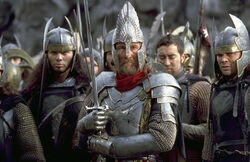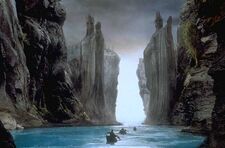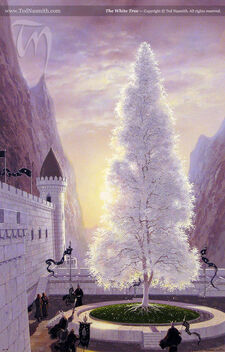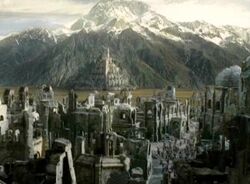Template:Semi-protected
Gondor was the prominent kingdom of Men in Middle-earth, bordered by Rohan to the north, Harad to the south, the cape of Andrast and the Sea to the west, and Mordor to the east. Its first capital was Osgiliath, moved to Minas Tirith in TA 1640. The city of Minas Tirith remained the capital of Gondor for the rest of the Third Age and into years of the Fourth Age; other major fortresses include Dol Amroth in Belfalas and Osgiliath, which was a city on the Anduin.
Gondor was founded by the brothers Isildur and Anárion, exiles from Númenor. Gondor was an allied kingdom with Arnor, whose line of king chieftains came from Isildur, while the Line of the Kings of Gondor was from Anárion. Gondor was at the height of its power in its early years due to the ships and the military might that its armies possessed. However, continued attacks by allies of Sauron, civil war, and a devastating plague caused it to gradually decline over the course of the Third Age until Sauron's final defeat and the crowning of Aragorn II Elessar. Following that time the power of Gondor once again expanded, until the former lands of Arnor were brought under the banner of the Reunited Kingdom.
In all, there were thirty-one kings of Gondor after Anárion, who was slain before Barad-dûr at the Siege of Barad-dûr.
History
Like Arnor to the north, Gondor was a Mannish kingdom founded by Anárion, the youngest son of Elendil, after the Downfall of Númenor. It was located to the South of Rohan and to the West of Mordor, on the Bay of Belfalas.
Early years

Elendil, the first King of Gondor
Before the Downfall of Númenor, Gondor was home to many Númenórean colonists, who either mixed blood with the indigenous Middle Men if they were friendly, or dispersed them into Ras Morthil, Dunland, and Drúadan Forest. Gondor, at a latitude comparable to Venice, was a more fertile region than Arnor to the north, and therefore it already had a larger population before the ships of Elendil's sons arrived, including a well-established city, Pelargir.
The Faithful, or Elendili, from Númenor were given a warm reception upon their arrival by those that had already colonized Middle-earth, including a colonial branch of Númenorean royalty at Dor-en-Ernil. The colonists north of Anduin accepted Elendil's claim to kingship over them. South of the Great River, however, the newly exiled Númenoreans did not recognize Elendil's claim.
Gondor was being founded after Númenor's population had already split between The Faithful and King's Men, and all of the more southern colonies (such as Umbar) remained enemies of The Faithful.
The newly founded kingdom of Gondor was then part of the Last Alliance of Elves and Men which overthrew Sauron for the first time at the very end of the Second Age, and when Isildur cut the finger of Sauron.
Gondor Prospers
After the war, Gondor's power and wealth grew steadily (only interrupted by an Easterling invasion in TA 492). Its power would continue to grow into the 9th century Third Age. While the power of Gondor's sister kingdom Arnor peaked during the 9th century, when it broke into various successor states, Gondor's greatest glory was yet to come. Gondor's great cities, Minas Anor, Minas Ithil, Osgiliath and Pelargir, only grew and the Dunedain of Gondor started to rule over more and more of the lesser people.
Gondor's Golden Age

The Argonath, monument to the Kings of Gondor.
Gondor's power reached its Golden Age under the four "Ship-kings":
- Tarannon Falastur r. TA 830 – TA 913. First of the Ship-Kings, died childless
- Eärnil I r. TA 913 – TA 936. Nephew of Tarannon
- Ciryandil r. TA 936 – TA 1015
- Hyarmendacil I (Ciryaher) r. TA 1015 - TA 1149. Last of the Ship-Kings. In the reign of the powerful king, Hyarmendacil I (c. 12th century TA) Gondor reached the height of its power. During Hyarmendacil's reign, Gondor's borders reached their furthest extent. The Kingdom extended east to the Sea of Rhûn, south to the nearest lands of the Haradrim, as far north as Mirkwood, and west towards the borders of Arnor.
Such was Gondor's wealth during the period that men from other lands would say in envy: "In Gondor precious stones are but pebbles for the children to play with." Gondor would also enjoy several centuries of peace due to its military might.

The White Tree of Gondor, originally planted in Minas Tirith by Isildur, was a symbol and coat of arms of Gondor
The Decline of Gondor
However, after decadence spread under the Kings of Gondor and a long period of decline began (although Gondor experienced several revivals). Three great calamities struck Gondor during the second millennium of the Third Age, which are held to be the chief reasons for its decline: the Kin-strife, the Great Plague, and the invasion of the Wainriders (a tribe of Easterlings).
The Kin-strife
In the 15th century TA a great civil war named the Kin-strife tore the nation apart. The current King Eldacar was of mixed blood: his mother was of the Northmen. Popular displeasure at this led to the overthrow of King Eldacar by Castamir, the admiral of all of Gondor's naval forces who possessed some royal blood. Eldacar's son was slain, and he fled north. Castamir was afterwards known as Castamir the Usurper. During his ten-year rule, he proved to be very cruel, and because of his love of his old fleet, he lavished attention on the coastal regions while the interior provinces were ignored and left to rot. Eldacar then returned with an army of his Northman kinsmen, and the armies of the Men of Gondor joined them from interior provinces such as Anórien. Osgiliath was devastated during this conflict, its great bridge destroyed and its Palantír lost. Eldacar slew Castamir and reclaimed his throne, but Castamir's sons and their forces were besieged in Pelargir, the great port of Gondor. They eventually retreated to Umbar, where they joined with the Corsairs, and troubled Gondor for many years, until their descendants died out.
The Great Plague
Later, the Great Plague struck and the White Tree died. This Plague was no localized event: the Plague swept through all of Middle-earth, reaching the successor states of Arnor and the Hobbits of the Shire in the North. King Tarondor found a sapling of the White Tree, and moved the capital from Osgiliath to Minas Anor, the City of Anárion. During this time, Gondor was so depopulated that the fortifications guarding against the re-entry of evil into Mordor were abandoned. It is believed that had the Haradrim or Easterlings been capable of attacking Gondor at this time, it would have fallen. However, the Plague left Gondor's enemies in no better condition than Gondor itself, and neither side was capable of mounting new offensives.
The Invasion of the Wainriders
Following the sapping of Gondor's strength by the plague, it did recover but then the Wainrider (Easterlings) invaded and devastated Gondor, and the conflict lasted for almost a century. The Wainriders destroyed the Northern Army of Gondor, but survivors linked up with the victorious Southern Army of Gondor which destroyed the Haradrim as they crossed the river Poros, led by a general named Eärnil, and they destroyed the Wainriders as they celebrated their victory during the Battle of the Camp.
The Line of the Kings Fails
Reunification Rejected
In TA 1944 Gondor faced a succession crisis when King Ondoher was slain in battle with both his sons. Arvedui, Prince of Arthedain, Ondoher's son-in-law, and the victorious general Eärnil, who was a distant blood-relative of Ondoher, claimed the throne. Arvedui's claim lay mainly in the reintroduction of the old Nùmenorean law of accession, which stated the eldest (remaining) child should succeed the king. If the law was reintroduced, then Arvedui's wife Fíriel, Ondoher's daughter and last remaining child, would become Ruling-Queen, making their descendants Kings of both Arnor and Gondor. Arvedui also tried to put weight behind his claim, as he was Isildur's heir. The council of Gondor recognised that the name of Isildur was held in honour in Gondor, but they dictated that the South-Kingdom must be ruled by an Heir of Anarion. Due to his ancestry from Fíriel and Arvedui, more than a millennium later, Aragorn Elessar put forward his claim as the heir of both Isildur and Anarion.
Eärnil laid his claim as being a direct descendant of King Telumehtar Umbardacil. His claim was also greatly bolstered by the popularity he had gained as the victorious general who saved Gondor from the Wainriders after winning the southern theatre of the war. Steward Pelendur who was temporarily ruling Gondor as serving as arbiter of succession, intervened in favour of Gondor's victorious general who would rule as Eärnil II.
The Last Heir of Anárion
During the Battle of Fornost, Eärnil II's heir Eärnur led Gondor's forces to victory over the Witch-king of Angmar, who was actually the Lord of the Nazgûl. Although Eärnur wished to fight him, Eärnur's horse was terrified and fled the battle against his wishes. By the time, he mastered his horse and returned the Witch-king had fled. Glorfindel the Elf then prophesied to him that it was better that he not fight the Lord of the Nazgûl because "never by the hand of man shall he fall".
Eärnur later ascended to the throne, ruling from Minas Anor ("Tower of the Sun"). During this time, the Ringwraiths captured the city of Minas Ithil ("Tower of the Moon"), renaming it Minas Morgul ("Tower of Dark Sorcery") and taking it as their lair. Minas Anor was renamed Minas Tirith (Tower of Guard) as a result. The Lord of the Nazgûl repeatedly sent messengers to Minas Tirith challenging Eärnur to single combat, taunting him that he had fled out of cowardice from facing him during the Battle of Fornost. Eventually, King Eärnur was overcome by wrath and rode with a small company of knights to Minas Morgul, to accept the challenge. They were never heard from again; and so ended the Line of Anárion.
The Stewards of Gondor
The Ruling Stewards
A long line of hereditary Stewards governed the realm after the disappearance of Eärnur, son of Eärnil, since there was no proof that the last king was dead, and no claimant had enough support to be accepted as his successor. The line of Anárion was held to have failed, and Gondor was not willing to risk to another Kin-strife, which would surely have destroyed it. Whenever there was a new Steward, he would swear an oath to yield rule of Gondor back to the King, in essence only an heir of Isildur, if he should ever return. In Gondor, there was no one who could claim descent from Isildur in direct line, and the northern line of Arnor had effectively disappeared, so this oath was not considered seriously. The line of Stewards ruled as Kings, without having the title. During the War of the Ring, the ruling Steward of Gondor was Denethor II, and his two sons were Boromir and younger Faramir- the latter being the last Ruling Steward of Gondor.
Cirion and Eorl
In TA 2510 when Steward Cirion ruled over Gondor, the nation faced one of its greatest perils: an Easterling tribe named the Balchoth invaded Gondor with mass force. Gondor's army marched to fight the Balchoth but were cut off from Minas Tirith and pushed back in the direction of the Limlight.
Messengers were sent to get help from the Éothéod, a tribe, which lived in the northern vales of the Anduin, but nobody expected the messengers to reach their destination. When certain peril came upon Gondor, however, the Éothéod turned the tide of the Battle of the Field of Celebrant. After the victory the Éothéod were awarded the fields of Calenardhon north of the White Mountains from the Gap of Rohan at the southern end of the Hithaeglir, Fangorn forest, rivers Limlight to Anduin, western Emyn Muil, and the Mering Stream, where they established the kingdom of Rohan with Eorl the Young as their first king. A permanent alliance between Gondor and Rohan was established by the oath Eorl swore to Cirion.
The War of the Ring and the Restoration
Several centuries later, Sauron had prepared for the final conquest, and in TA 3018 his forces overran Ithilien. The attack was stopped at Osgiliath with the destruction of the bridge across the Anduin. The following year Minas Tirith faced a larger attack from Mordor, with additional threat from the Corsairs of Umbar. Aragorn summoned the Dead Men of Dunharrow to destroy the forces from Umbar, freeing forces in the south of Gondor to come to the aid of Minas Tirith. Gondor then defeated the army of Mordor with the aid of the Rohirrim in the Battle of the Pelennor Fields, though with heavy losses. The combined army of the West then carried the battle to Sauron at the Battle of the Morannon, a feint to distract Sauron's attention from Frodo Baggins's quest to destroy the One Ring in Mount Doom, thus causing Sauron's destruction and the allies' ultimate victory.
After the second and final defeat of Sauron, the Kingship was restored, with Aragorn crowned as King Elessar of the Reunited Kingdom of Arnor and Gondor. Faramir, last heir of the Ruling Stewards, retained his office as the Steward to the King, and ruled over Gondor's eastern region of Ithilien; a fair land between the river Anduin and the Ephel Dúath. The oaths between Gondor and Rohan were renewed, and several joint campaigns were fought in the east and south against the remnant of the Easterlings and Haradrim; all former territories of the South-kingdom were won back during the following centuries, and its power and wealth were restored. Several Tolkien's writings state that "...of Eldarion son of Elessar it was foretold that he should rule a great realm, and that it should endure for a hundred generations of men after him, that is until a new age brought in again new things; and from him should come the kings of many realms in long days after".[1][2][3]
Armies
Second Age
The soldiers of Gondor were renowned during the Second Age for their skill and valour. Training men of Gondor during the Second Age instilled within their soldiers a martial spirit and ardor, goading them to fight to the death against the hordes of Mordor, Rhûn, and Harad. Every man was physically imposing: being very tall at over six feet, very broad, and very strong as well. Every single soldier was in peak fighting condition and ready to fight against Sauron's hordes (especially during the War of the Last Alliance). The three major weapons they used were spears, longswords, and longbows. They also knew how to form cohesive box-formations, which were sturdy enough for both offensive and defensive purposes. The soldiers wore heavy plate armour and utilised large shields made out of multi-layered wood and edged in metal for reinforcement.
Third Age
Gondor's armies prevented Mordor and its allies from overwhelming the rest of Middle-earth. Gondor was in a very crucial position, in order to guard Middle Earth and because of Gondor's proximity to Mordor, its military forces had to be proficiently trained and vigilantly on guard at all times. Because of this, they were arguably the strongest country that opposed Sauron. During the Third Age, most of Minas Tirith's armies were trained and drilled to fight in tight infantry formations, supported by archers and cavalry. Their armaments consisted of a chainmail undercoat with either a black tabard or plate armor over it. Their standard weapons were long spears, longswords, and longbows, complimented by tower shields.
Minas Tirith's immediate defenses comprised thousands of infantrymen stationed throughout Osgiliath, Cair Andros, and the Rammas Echor. These units were most likely temporary detachments from the city. Minas Tirith also had at least three companies of the elite Guards of the Citadel, tasked to defend the upper levels of the city. They wore black robes, surcoats and winged silver crowns. The Guards of the City were not allowed to go in the main part of the City in their uniform. Additionally, the sixth level of the city housed stables for a small force of horsemen. Beyond Anduin and the defenses of Minas Tirith operated a secretive group of soldiers called the Rangers of Ithilien The Rangers of Ithilien had guerrilla warfare aginst the Southrons, allies of Mordor. Similar to the Rangers of the North, the Rangers of Ithilien were comprised of the remnant of the Dúnedain in their respective Kingdom, in this case being the Dúnedain that once dwelled in Ithilien.(the Rangers of the North were Arnorian Dúnedain, while the Rangers of Ithilien are Gondorian- and were more populous than their northern kin). Armed with longbows, swords, and spears, these men watched and harassed the enemy throughout Ithilien, much akin to guerrilla warfare. The captain of the Rangers of Ithilien during the War of the Ring was Faramir, the younger brother of Boromir and the son of the Steward of Gondor, Denethor II.
The defense of Gondor's fiefdoms were the responsibility of the respective lords of these territories. Their training, strength in numbers, and armaments varied from each fief (Lossarnach brought axemen to the aid of Minas Tirith while the men of Morthond Vale consisted of archers). The greatest of these fiefs was Dol Amroth, which brought forth the largest force to Minas Tirith, made up of men-at-arms and arguably the best cavalry in Middle Earth- the elite Swan Knights.
Gondor's fleet at the time of the War of the Ring was docked at Pelargir. This port and the Anduin River was essential in the defense of Minas Tirith. As made evident by the fiefdom's dire need to defend their coasts and many rivers of Gondor, a majority of the fleet was concentrated at Pelargir. This fleet was destroyed when the Black Ships of Umbar attacked, enslaving many of Gondor's sailors into the service of Mordor.
Song of Gondor
Gondor! Gondor, between the Mountains and the Sea!
West Wind blew there; the light upon the Silver Tree
Fell like bright rain in gardens of the Kings of old.
O proud walls! White towers! O wingéd crown and throne of gold!
O Gondor, Gondor! Shall Men behold the Silver Tree,
Or West Wind blow again between the Mountains and the Sea?
This was sung by Aragorn on his trip with Legolas and Gimli to find Pippin and Merry.
Etymology
Gondor name means 'Land of Stone', from Sindarin gond (stone) + (n)dor (land), most likely given to it because of the White Mountains (Ered Nimrais) and other mountain chains in the land (hypothetical Quenya name Ondonórë).[2]
Regions of Gondor

Map of Gondor

Gondor was divided between several nearly autonomous regions. These were the following:
- Ithilien, a region along the east bank of the Anduin river under the shadow of the Ephel Dúath (Mountains of Shadow). Ithilien was abandoned and mostly under the control of Mordor during The War of the Ring. (Although Gondor did have secret bases throughout the region such as Henneth Annûn, and the Rangers of Ithilien used guerilla warfare tactics to harass the enemy throughout Ithilien, and disrupt supply lines and companies marching to and from Mordor. After the War of the Ring, Faramir was made Lord Paramount of Ithilien by Aragorn.
- South Ithilien, a portion of the the Ithilien south of Osgiliath. The road (the Harad Road) the Southrons took to get to Morder lied here.
- Anórien, a strip of land along the northern edge of the White Mountains. Bordered by the Mering Stream and Rohan to the west, Anduin to the east, the Mouths of Entwash to to the north, and theWhite Mountains and Rammas Echor to the south.
- Lossarnach, a heavily-populated farmland region southwest of Minas Tirith.
- Lebennin, a plain extending from the White Mountains down to the Bay of Belfalas that bordered Lossarnach.
- Belfalas, a fiefdom ruled by the Princes of Dol Amroth.
- Dor-en-Ernil, a narrow strip of land along the Bay of Belfalas ruled by the Princes of Dol Amroth.
- Lamedon, a plain between the White Mountains and the River Ringló.
- Anfalas or Langstrand, a narrow strip of land along the sea bordered by the Pinnath Gelin.
- Andrast, The western-most province of Gondor located on a narrow peninsula jutting out into the Sea.
- Ringló Vale, a mini-province.
- Morthond or Blackroot Vale, where Duilin comes from.
The long cape of Andrast was not populated (by the descendants of Númenóreans, but evidence from the Unfinished Tales suggests that a small group of Púkel-men inhabited it.)
Additionally, Gondor held or had held the following regions at certain points in its history:
- South Gondor or Harondor, an arid region between the rivers Poros and Harnen, which was contested between Gondor and Harad.
- Calenardhon, which was given to the Éothéod and became Rohan. It's boundaries were the rivers of Anduin in the east, Isen in the west, Limlight in the north, and the White Mountains/ Mering Stream in the south.
- Enedwaith, a region between the rivers Isen and Greyflood. It was never truly populated by Gondor and was soon abandoned.
- Rhovanion, which was never fully under the control of Gondor but under Gondorian control at certain times during the Third Age.
- Ephel Dúath, the Mountains of Shadow, which was the extreme eastern region of Gondor where she kept watch over Mordor with many fortresses and cities such as Minas Ithil, Durthang, and the Tower of Cirith Ungol. Evil things re-entered Mordor after Gondor's watch upon the land slackened during the Second Age.
Major Sites

Minas Tirith
Cities, Fortresses, and Strongholds in Gondor included:
- Cair Andros, an island-fortress in the river Anduin, roughly 40 miles north of Osgiliath. Gondor maintained a steady garrison here, as it was of paramount importance to Gondor during the long war with Mordor, in order to prevent the enemy from crossing the river and entering into Anórien.

The ruined city of Osgiliath.
- Calembel, a city in Lamedon.
- Dol Amroth, a city in Belfalas ruled by the Prince of Dol Amroth.
- Ethring, a ford and a large township built on either side of the river Ringló.
- Henneth Annûn, a hidden refuge of Gondorian rangers in the northern part of Ithilien along the Ephel Duath, the Mountains of Shadow.
- Linhir, a port city in Lebennin.
- Minas Tirith (originally Minas Anor), City of the Kings, the capital (Third Age) and largest city of Gondor.
- Osgiliath, a city and former capital of Gondor on the river Anduin, largely destroyed and abandoned by the end of the Third Age. During the War of the Ring, Gondor kept a garrison on the west bank to prevent the Enemy from crossing the river and assaulting Minas Tirith. Osigiliath was the key to besiege Minas Tirith because of its location and access to the river. Although the massive Morgul-host led by the Witch-King to beseige Minas Tirith overwhelmed the garrison, and drove the Gondorians out thus gaining the passage of Anduin- the true beginning of the Siege of Gondor that would conclude at the Battle of the Pelennor Fields. King Elessar had it rebuilt after Sauron's downfall.
- Pelargir, the great southern harbour, which was captured by the Corsairs during the War of the Ring. The people of Pelargir helped in the Batttle of Pell
- Tarnost, a hill-town in Belfalas.
Additionally, Gondor had held the following locations at certain points in its history:
- Angrenost (Isengard), one of the three Fortresses of Gondor and held within it one of the realm's Palantiri. Its location in Nan Curunir (valley at the end of the Misty Mountains), was at the northwestern corner of the Southern Kingdom of Gondor, guarding the Fords of Isen from enemy incursions into Calenardhon, and together with the fortress of Helm's Deep to its south protected the Gap of Rohan. After Calenardhon was given to the Éothéod by Cirion, Steward of Gondor and became Rohan, Isengard remained part of Gondor, and the company of Aglarond removed to the northern fortress, although the rest of Gondor almost forgot about it. The small guard intermarried much with the Dunlendings , until the place became a Dunlending fortress in all but name. Orthanc, however, remained closed, as the Steward of Gondor still held the keys. Isengard soon came all but deserted.
- Durthang, the largest fortress in Mordor, originally built to guard the Ephel Dúath (Mountains of Shadow)..
- Erech, a town of Gondor that was abandoned by the end of the Third Age. To the north lay the Paths of the Dead.
- Minas Ithil, a city founded by Isildur that was originally the sister city of Minas Anor. Located in an upland valley at the feet of the Mountains of Shadow, it was built as a fortress city to defend Gondor from Sauron in Mordor. It was later conquered by the Nazgûl and renamed Minas Morgul.
- Tharbad, a city on both sides of the river Greyflood, (at one time held by Gondor in the south and Arnor in the north) but abandoned as Gondor's borders recessed through Enedwaith to the Isen, and later ruined.
- Tower of Cirith Ungol, a Tower Fortress in western Mordor built by Gondor to guard the pass of Cirith Ungol from any evil creature trying to enter -or leave- Mordor. The Great Plague wiped out the garrison located here, so it was easily captured when Sauron's minions re-entered Mordor.
- Towers of the Teeth, two towers situated on either side of the Black Gate. The two towers, called Carchost and Narchost, that stand on either side of Cirith Gorgor, the Haunted Pass, which lies between the Ephel Dúath (Mountains of Shadow), and the Ash Mountains. Originally built by Men of Gondor following the downfall of Sauron at the end of the Second Age, the Towers of the Teeth were eventually taken over by the servants of the Dark Lord. They were then repaired and fortified and were incorporated into the defenses of the pass and gate.
- Umbar, the far southern harbour which was lost and reclaimed several times, in the end being the home of Black Númenóreans, the Corsairs of Umbar.
Trivia
- Gondor draws heavy influence from the real medieval Byzantine Empire[citation needed]; both had numerous enemies (Gondor faced the Haradrim, Easterlings and Sauron's forces, the Byzantine Empire faced the Persians, Turks, and on occasion the Catholic West) and both were in a state of decline on the eve of a final, dramatic siege on their capital that would determine the fate of the Empire/Kingdom, though Minas Tirith survived and Constantinople did not. Tolkien wrote a letter in 1951 describing the "Byzantine City of Minas Tirith". They were also the only surviving remnants of their respective Empires (Western Rome having fallen almost a millennia before the East, with a similar time-scale for Arnor before Gondor).
- This influence is echoed in Peter Jackson's film adaptation - Byzantine domes were incorporated into the architecture of Minas Tirith, the civilians wore Byzantine attire, and Minas Tirith's soldiers were based on pre-11th century Byzantine infantry.
See also
- Kings of Gondor
- Stewards of Gondor
- Rivers of Gondor
- Minas Tirith (Capital of Gondor)
- Men of Gondor
- Rohan (Country allianced with Gondor)
Translations around the world
| Foreign Language | Translated name |
|---|---|
| Amharic | ጎንዶር |
| Arabic | غوندور |
| Armenian | Գոնդոր |
| Belarusian Cyrillic | Гондар |
| Bengali | গনডোরে |
| Bulgarian Cyrillic | Гондор |
| Catalan | Góndor |
| Chinese (Mainland) | 刚铎 |
| Chinese (Hong Kong) | 剛鐸 |
| Georgian | გონდორი |
| Greek | Γκόντορ |
| Hebrew | גונדור |
| Hindi | गोन्दोर |
| Japanese | ゴンドール |
| Kannada | ಗೊಂಡೋರ್ |
| Kazakh | Гондор (Cyrillic) Gondor (Latin) |
| Korean | 곤도르 |
| Kyrgyz Cyrillic | Гондор |
| Macedonian Cyrillic | Гондор |
| Marathi | गोन्दोर |
| Mongolian Cyrillic | Гондор |
| Nepalese | गोनदोर |
| Pashto | ګوندور |
| Persian | گاندور |
| Punjabi | ਗੋਂਡੋਰ |
| Russian | Гондор |
| Serbian | Гондор (Cyrillic) Gondor (Latin) |
| Sindhi | خوبصورت |
| Sinhalese | ගොඳොර් |
| Tajik Cyrillic | Гондор |
| Tamil | கொண்டோர் |
| Telugu | గొండోర్ |
| Thai | กอนดอร์ |
| Ukrainian Cyrillic | Гондор |
| Urdu | گونداور |
| Uzbek | Гондор (Cyrillic) Gondor (Latin) |
| Yiddish | גאָנדאָר |
| Amon Ereb • Forest of Brethil • Dor-lómin • Eriador • Estolad • Ladros | |
| Arnor • Dunland • Gondor • Haradwaith • Númenor • Rhûn • Umbar | |
| Arnor (later split into Arthedain, Cardolan, and Rhudaur) • Rohan • Dale • Dunland • Lake-town (later part of the kingdom of Dale) • Gondor • Haradwaith • Khand • Rhovanion • Rhûn • Umbar • Vales of Anduin | |
| Dale • Haradwaith • Núrn • Reunited Kingdom of Gondor and Arnor • Rohan • Rhûn • Khand • Eriador • Vales of Anduin | |
| People: Faramir · Sauron · Witch-king of Angmar · Gollum · Elrond · Frodo Baggins · Samwise Gamgee · Meriadoc Brandybuck · Peregrin Took · Gandalf · Aragorn II · Legolas · Gimli · Boromir · Galadriel · Elves · Hobbits Locations: Middle-earth · Gondor · Mordor · Rohan Other: Mithril · Middle-earth Strategy Battle Game · The Fellowship of the Ring: Being the First Part of The Lord of the Rings · Works inspired by J. R. R. Tolkien · The Lord of the Rings · The Lord of the Rings (1978 film) · Ainulindalë · Tolkien vs. Jackson · Tengwar · Quenya |
